Wappenham, UK – Radio Frequency (RF) solutions manufacturer SPX CommTech launches its next generation Evenlode Video and Audio Encoder / Decoder, developed by Enterprise Control Systems (ECS). The lightweight, low-power unit can be installed on manned and unmanned air platforms, providing real-time intelligence-gathering, incident response, and civilian safety. It will be shown first at DSEI, Excel London, stand H2-874, between 12-15 September 2023.
Evenlode Video and Audio Encoder / Decoder supplies high-efficiency video coding (HEVC) H.265 low-latency encoding to deliver superior multi-video compression for efficient video recording and real-time, secure distribution. Latency below 120 milliseconds end-to-end means images are transferred and received in real-time, enabling greater situational awareness, and more accurate, faster response.
It significantly reduces the required bandwidth to transfer the same – or better – quality video and audio data than existing models in the market. Considering the limited RF bandwidths available to defense, security and policing organizations, access to freed-up IP allows greater flexibility for sharing critical data through encrypted file shares. It also allows greater use of applications such as electro-optical/infrared sensors, and tracking and location data being shown on a moving map – all improving incident response.
The decoder mirrors the encoding capabilities, allowing the real-time re-streaming – or transcoding – to multiple destination points such as a command centre or at the tactical edge using mobile devices. This adds flexibility to users’ video distribution aims in one single solution.
The upgraded video and audio Data Link solution, which is the latest in the ECS Evenlode series, delivers highly sought-after 4K Ultra High Definition video image quality. This delivers a maximum system resolution of 1080p60 and enhances the image after compression, making it easier to identify details and potential threats.
The device is certified to RTCA DO160G standard, which assures the performance characteristics of the equipment required for kit fitted to airborne manned, fixed and rotary-wing aircraft.
It’s backwards compatible with ECS’ operationally-proven legacy equipment, meaning users can keep up to date with the latest decoding technology without upgrading their entire systems.
Tactical Data Links provide the ability for aircraft to become network-enabled across land, sea and air and, therefore, able to carry out Intelligence, Surveillance and Reconnaissance (ISR) missions across all of them. Data is transmitted using sophisticated, in-house designed encryption software. The new Encoder / Decoder has six separate video inputs – four HD and two SD – capable of encoding four videos simultaneously. This allows users to select the latest mission-critical information required without disrupting the operation and simultaneously process multiple video inputs for improved situational awareness.
“The ability to record, receive, and stream real-time high-quality video and data is critical for all defense, security, and policing organizations charged with securing their nation’s population and Critical National Infrastructure (CNI). At SPX CommTech we’re committed to providing solutions that allow faster, more detailed communication across longer distances”, says Jackson White, Business Development Director of Tactical Data Links and VP Marketing, SPX CommTech. “The launch of the new Evenlode Video and Audio Encoder / Decoder is part of our continued strategic development of technologies that ensure a smarter, more secure future for all by delivering fast and accurate ISR data so timely and effective decisions can be made on the tactical edge.”
SPX CommTech continues to innovate Data Link solutions to provide critical support to defense, security, and policing organizations worldwide.
The new Evenlode Video and Audio Encoder / Decoder is now available to order. For more information, visit www.enterprisecontrol.co.uk or book a time to discuss your Data Link needs with us at DSEI (Excel London, 12-15 September 2023) by emailing sales@enterprisecontrol.co.uk.
About SPX CommTech – ECS
Enterprise Control Systems (ECS), as part of the SPX Technologies’ CommTech Platform, innovates specialized technologies within the Radio Frequency (RF) spectrum to ensure a smarter, more secure future for all.
SPX CommTech’s Tactical Data Link portfolio allows organizations that are conducting airborne ISR operations in the defense, security, and policing environments to transfer video and data securely and reliably between enabled aircraft and ground users over long distances in congested RF environments.
Combining decades of technology innovation and expertise with agile and collaborative teams, SPX CommTech delivers sustainable and exceptional results to customers across the globe – in regions including Europe, APAC, the Middle East and Africa.
For more information on SPX CommTech Tactical Data Links, visit www.enterprisecontrol.co.uk







